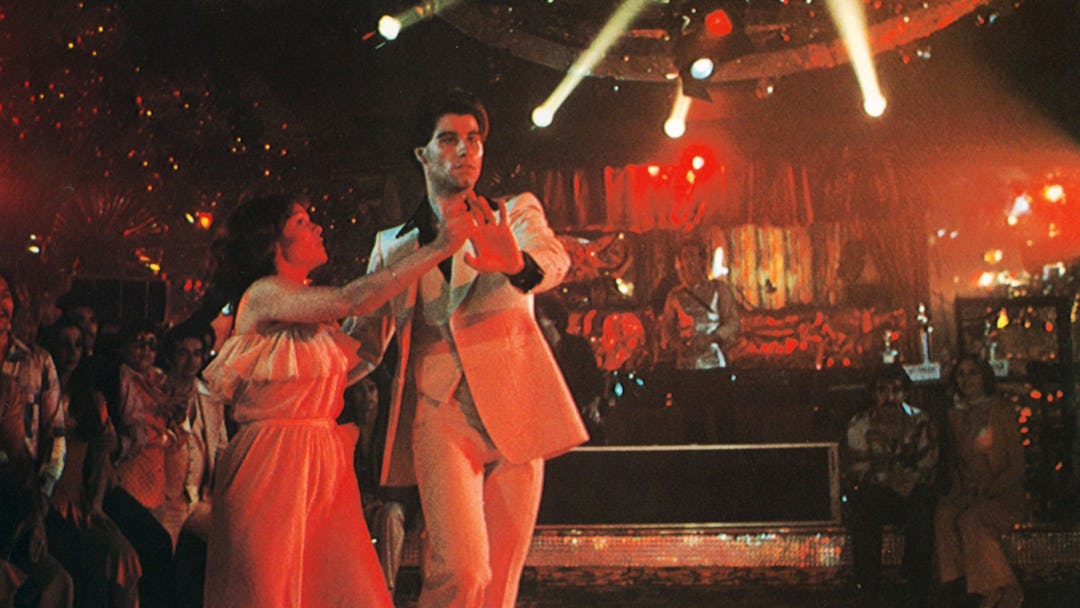In retrospect, it’s surprising there weren’t more disco movies. It’s not that there was a shortage – “Dim All The Lights: Disco and the Movies,” a new series at New York’s Metrograph, has plenty, both from that era and looking back on it, and the program is explicitly labeled as “by-no-means-exhaustive.” But considering how eager Hollywood is to leap onto the next big thing and beat it like a dead horse, you’d think disco flicks would have been the superhero movies of their day. After all, before Thriller, the best-selling album of all time was both a disco record and a movie soundtrack.
That movie was, of course, Saturday Night Fever, a film whose influence on the music’s iconography can’t be overstated; no single movie was more responsible for the common conception of what disco was, both as a music and as a scene. Ask anyone what they think of when they think of disco, and there’s about a three-in-four chance they’ll do Travolta pointing at the ground, and then pointing at the heavens. That a movie about the music is arguably more beloved than the music itself isn’t as much a slam on the music as it is a tribute to how well it lent itself to film.
There’s probably no musical genre as bound to cinema, at least in terms of capturing what exactly that music was to those who loved it. Elvis movies and early rock jukebox films – you know, those ‘50s flicks where Little Richard or Chuck Berry or Bill Haley would show up every couple of reels to stop the dopey plot and sing one of their hits – gave audiences the electricity of the music, but the music remained the focus, and they could hear it at home on their phonographs. Disco on the other hand, wasn’t just a sound on a record – it was an experience. The music was just part of the equation, alongside the dancing, the lighting, the clothes, the drugs, the scene. You didn’t get the full flavor of those rooms by just listening to a disco record. Cinema could put you in that room.
And the fact that it wasn’t all on wax was, as many have noted before, part of why rock dudes hated it. Rock and its fans were also in a period where a predisposition against disco was sort of inevitable – rock at the time was “all about the music, man,” filled with lookalike guys doing self-indulgent solos. Disco haters were often responding only to the music, because the music was all they knew – they didn’t have a disco to go to, or if they did, you couldn’t drag them there (and the fact that disco attracted queer, ethnically diverse and female fans in droves makes the anti-disco movement sound like a more benign cultural precursor to Trump rallies). A recent, terrific oral history of the notorious “Disco Demolition Night” included this prototypical complaint, from restaurateur Kevin Hickey: “My friends and I hated disco, but by 1979 everybody was listening to it. You felt you weren’t pretty enough or skinny enough to fit into it. I was a chubby kid. I remember [Disc jockey and “Demolition Night” organizer Steve Dahl] saying the reason he hated disco so much was because he couldn’t buy a three-piece white suit off the rack. That stuck with me because I couldn’t either.”
That’s a fairly agreed-upon explanation for the anti-disco movement, but the flip is examined less: that for, say, a bullied gay teenager in Oklahoma circa 1978, disco cinema offered a light in the distance, a promise that there was a whole other world out there awaiting you, one where you could be yourself, dance, and have a great time.
That feeling permeates Will You Dance With Me?, the long-lost Derek Jarman film that kicks off the Metrograph series this week. It’s not really a proper film at all – Jarman was invited by director Ron Peck and writer Mark Ayres to take a raw recording of a night at Benjy’s, a gay club in East London, for another project. He shot Will You Dance With Me?, on VHS, and you can hardly imagine a worse format for nightclub photography – the lights are smeary, the sound is tinny, and there are moments where the darkness of the room keep you from making out much of anything. But the combination of the spotty lighting and the darkness of the image ends up abstracting the dancing in interesting ways, and clarity hardly matters anyway – the joy and freedom still peek through.
Early on, only a handful of brave souls approach the dance floor; conversations are unintelligible, and everyone looks either self-conscious or miserable. Jarman’s observational style doesn’t let you out of that room, and for a time, Will You Dance With Me? almost seems like a contradiction of the choreographed, well-designed fantasies promised by conventional disco movies. But as he’s scoping out the room, you find yourself drawn to some of these people – the cheery old gay guy dressed all in white, the office ladies in their giant glasses, the two guys meeting on the dance floor and hitting it off. By the end of the night, the floor is full, of all types: gay and straight, black and white, hip and square. Everyone’s laughing, showing off, vibing. It looks, all in all, like a pretty good time.
Metrograph’s “Dim all the Lights” series begins tonight with Will You Dance With Me?
